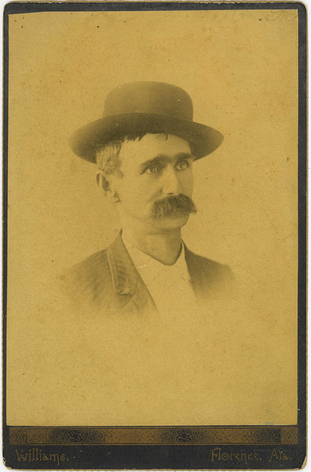 In September 1872, Florence City Marshal William Edward Blair led a posse to intercept and capture members of the Clifton Shebang who had robbed Florence homes and terrorized the region for years. The gang caught by surprise included the infamous Mountain Tom Clark and two accomplices. (Courtesy Lee Freeman)
In September 1872, Florence City Marshal William Edward Blair led a posse to intercept and capture members of the Clifton Shebang who had robbed Florence homes and terrorized the region for years. The gang caught by surprise included the infamous Mountain Tom Clark and two accomplices. (Courtesy Lee Freeman) The first record of Tom Clark and the Clifton Shebang comes from an 1865 report by Captain Lot Abraham of Co. D, Fourth Iowa Cavalry, USA. Reporting to his superior about robberies by Union troops stationed near Florence, Alabama, Captain Abraham stated: “Several citizens told me they believed most of the robbing had been done by men who were with Lieutenant Thrasher.” Among them, he listed Tom Clark.
Before he was brought to justice by a Florence mob in 1872, Clark boasted of killing many men. Among his victims were three people at the Wilson Plantation and three Confederate soldiers who happened to come across Clark as he was hunting another man.
According to Dr. Wade Pruitt, author of the only book about the Buggers, Tom Clark was one of twenty Buggers who conducted the raid on the Wilson plantation. They conducted a second raid into Florence in September of 1872, the criminal escapade that was to become Mountain Tom’s downfall.
The Lauderdale Times Extra of September 5, 1872, reported that, after several houses were robbed in Florence, two men were spotted “driving a sorrel mare [hitched] to a buggy” at two o’clock in the morning. At sunrise, a posse led by Florence City Marshal William Edward Blair left in pursuit of the outlaws.
According to the Times, the posse caught up to the gang near Gravelly Springs. The “elegantly dressed” outlaws, who had stopped for dinner and were in the process of unhitching their horses, were caught by surprise and put up no resistance to Marshal Blair and his men. A search of the outlaws discovered nothing. However, upon examining the buggy, a breastpin was spied sticking out of the buggy top’s lining. According to the paper, the deputies found eight watches, a handful of breastpins, and other items. Upon opening a traveling salesman's satchel the officers found “files, saws, and other burglarious instruments.”
Seeing that they were both caught and outnumbered, the outlaws surrendered their arms and were promptly placed under arrest and taken back to Florence.
Thus the notorious outlaw Tom Clark met his end. Mayor Neander H. Rice ordered the bodies buried “in one of the old fields near our town.” But a legend begun perhaps in the 1930s or as late as the 1960s has it that one of the men on the burial detail remembered hearing Clark boast that “no one ever run over Tom Clark.” He got the idea to bury the outlaw outside the cemetery underneath East Tennessee Street so that everyone would “run over” Tom Clark.
This burial legend is not supported by any of the newspaper reports of the time, nor is it mentioned in subsequent accounts of the lynching. Still, a historic marker in Florence tells the story of Mountain Tom's notorious career as an outlaw, his hanging, and his ignominious burial under Tennessee Street. The true location of the outlaw's final resting place is a mystery, but his legend remains to tell a tale of turbulent times in post-Civil War Alabama.
This article was originally published in Alabama Heritage Issue #82, Fall 2006.
Author
Florence, Alabama, native Lee Freeman is the head of the Local History and Genealogy Department of the Florence-Lauderdale Public Library. He has taught and lectured on Lauderdale County history and genealogy and was featured in the documentary history of Lauderdale County entitled Follow the River.
 RSS Feed
RSS Feed